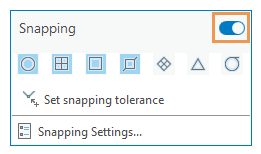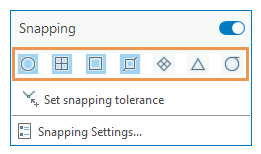Snapping  consists of a collection of snap agents that you enable or disable to snap the pointer to specific feature geometry such as to the nearest vertex or intersection. Snapping is turned on or off on the Edit tab and on the status bar at the bottom of the active map.
consists of a collection of snap agents that you enable or disable to snap the pointer to specific feature geometry such as to the nearest vertex or intersection. Snapping is turned on or off on the Edit tab and on the status bar at the bottom of the active map.
If snapping is turned on, enabled snap agents become active when the pointer hovers near a feature within the snapping tolerance distance. Press and hold the spacebar to temporarily turn off snapping as you create, modify, or measure features.
When you use snapping, consider the following:
- Snapping settings for 2D and 3D workflows, snap tips, and other settings can be customized in Editor Settings.
- To isolate snappable layers, turn snapping off by layer.
Turn snapping on
To turn snapping on, complete the following steps:
- On the ribbon, click the Edit tab. In the Snapping group, click
Snapping
 .
.Alternatively, on the status bar at the bottom of the active map or scene, click the Snapping button
 .
.
Or, hover over the button until the pop-up dialog box appears, click the Snapping toggle button, and move the pointer back to the map.

Enable snap agents
To enable snap agents, complete the following steps:
- On the ribbon, click the Edit tab. In the Snapping group, click the Snapping drop-down arrow
 .
.Alternatively, hover over the Snapping button
 on the status bar at the bottom of the active map or scene.
on the status bar at the bottom of the active map or scene. - On the snapping dialog box, click a snap agent to enable or disable it.
Enabled snap agents appear shaded.

Point

Snap to the nearest point or LAS point feature.
Endpoint

Snap to the nearest start point or endpoint of a polyline feature.
Vertex

Snap to the nearest vertex of a polyline or polygon feature.
Edge

Snap to the nearest edge of a polyline or polygon segment.
Intersection

Snap to the nearest intersection of two or more lines or edges.
Midpoint

Snap to the nearest midpoint of a polyline or polygon segment.
Tangent

Snap to the nearest point of tangency on an arc or curved segment.